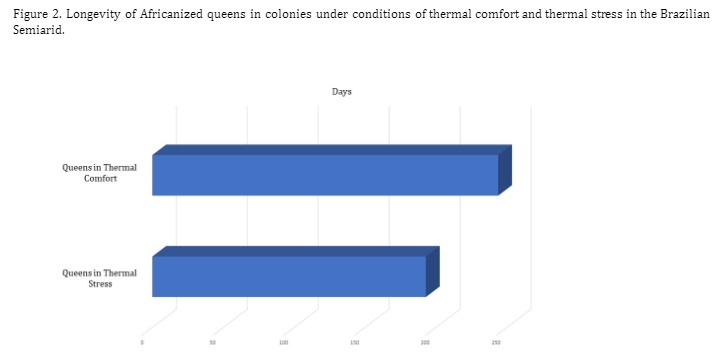Comparative study of the performance of africanized bees managed in thermal stress and thermal comfort in a semiarid region.
DOI:
https://doi.org/10.21708/avb.2023.17.4.12083Abstract
In most of the Brazilian Semiarid region, the climate with high temperatures, low rainfall, and high levels of solar radiation are considered factors that can harm or compromise the thermal comfort of bees, especially if they are in a non-shaded environment, thus generating many losses and growth difficulties in the sector. This study aimed to compare the performance of Africanized bee colonies subjected to two distinct situations: thermal comfort and thermal stress. For this, standardized hives containing sister queens of the same age were monitored every 15 days to survey the combs regarding the areas occupied with pollen, honey, laying, open and closed brood until the queens died. Hives under thermal comfort conditions had a larger area of capped brood (20.66 ± 3.81%), significantly higher (p = 0.0106) than hives under thermal stress (15.76 ± 2.62%). In addition, the lifespan of queens managed under thermal comfort was longer (244 ± 71 days) than that of queens under thermal stress (193 ± 63 days), although we did not find a statistically significant difference. It can be concluded that the development of the colonies when they are in thermal comfort presents better performance, especially with regard to the growth of the brood area. Therefore, it is important to apply shading to hives in beekeeping in regions with hot and dry climates.
Downloads

Downloads
Pubblicato
Fascicolo
Sezione
Licenza
Copyright (c) 2024 Acta Veterinaria Brasilica

TQuesto lavoro è fornito con la licenza Creative Commons Attribuzione 4.0 Internazionale.
Autores que publicam na Acta Veterinaria Brasilica concordam com os seguintes termos: a) Autores mantém os direitos autorais e concedem à revista o direito de primeira publicação, com o trabalho simultaneamente licenciado sob a Licença Creative Commons Attribution que permite o compartilhamento do trabalho com reconhecimento da autoria e publicação inicial nesta revista. b) Autores têm autorização para assumir contratos adicionais separadamente, para distribuição não-exclusiva da versão do trabalho publicada nesta revista (ex.: publicar em repositório institucional ou como capítulo de livro), com reconhecimento de autoria e publicação inicial nesta revista. c) Autores têm permissão e são estimulados a publicar e distribuir seu trabalho online (ex.: em repositórios institucionais ou na sua página pessoal) a qualquer ponto antes ou durante o processo editorial, já que isso pode gerar alterações produtivas, bem como aumentar o impacto e a citação do trabalho publicado (Veja O Efeito do Acesso Livre).


 Esta obra está licenciada com uma Licença
Esta obra está licenciada com uma Licença 